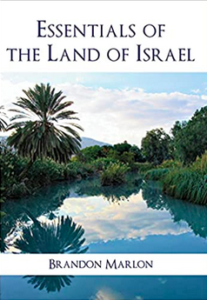By Fred Reiss, Ed.D.

WINCHESTER, California – Anyone perusing the table of contents of Essentials of the Land of Israel by Brandon Marlon, a prolific, award-winning Canadian-Israeli author, would correctly conclude the book’s value lies in its treatment of the country’s geography. Yet, Essentials of the Land of Israel is so much more.
Essentials of the Land of Israel includes 15 photographs, and each chapter holds at least one detailed map. Chapter 1, “Borders of Israel,” has six such maps covering Israel’s history from Exodus to Ezekiel. Chapter 2 chronicles Israel’s 8 historical capitals, including the lesser-known towns of Shiloh, Givah, and Mahanayim. Chapters 3 through 9 characterize Israel’s most prominent and significant mountains, valleys, rivers, lakes, seas, deserts, and forests, portraying more than 175 in total.
Interlaced within each broad geographical type lies many examples of both well-known and less-visited natural landmarks along with stories about their history and national importance from antiquity to the present, plus typography and natural resources. One such example is Beit She’an Valley, described as a highly fertile land with many springs joining the Jordan Rift Valley with the Harod and Jezreel Valleys. Also presented is the valley’s extensive history, beginning with its allotment to the tribe of Issachar, through Egyptian rule, the Philistine encroachment during the reign of King Saul, and on to King Solomon’s reign, the Hellenistic Era, and Roman and Islamic rule.

Geographic chapters comprise about three-quarters of the book. The last quarter describes previously presented places, now emphasizing their unequivocal attachment, significance and meaning to the Jewish nation. In Chapter 10, “Heartland of the Homeland”, Marlon writes, “In the contemporary political climate, ceding these foundational areas remains an ongoing possibility, and many individual Jews disconnected from their heritage and their history remain unacquainted with what these crucial regions of the Land of Israel mean to the Judaic civilization and to Jewry as a whole.” He successfully raises awareness of the historical impact of Israel’s geographical features on the Jewish people.
The final two chapters offer comprehensive descriptions of “must-see sites” in and around Israel. The three appendices are historical, covering Israel under David, Solomon, and the Maccabees.
Essentials of the Land of Israel, an excellent reference for biblical and historical studies, is a wonderfully presented and easily accessible encyclopedic encounter with the “Land” of the Land of Israel, enveloped in its own history, import, and meaning for contemporary Jewry.
*
Fred Reiss, Ed.D. is a retired public and Hebrew school teacher and administrator, and author of a number of books, including The Jewish Calendar: History and Inner Workings and The Comprehensive Jewish and Civil Calendars, 2001 to 2240. He may be contacted via fred.reiss@sdjewishworld.com and info@fredreissbooks.com.